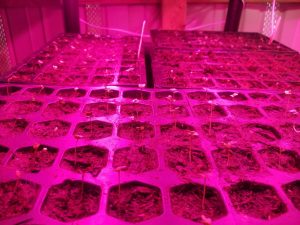In my garden and near the river, the impact of seasonal climate change can be seen. We have had two significant, but not devastating, floods in this neighborhood over the past year. My neighbors, who have lived here for decades, say that this type of flooding typically happens ever few years. Seeing these water levels twice in four months is unusual. FEMA records show flood waters in this area reaching this level in 2021, 2020, 2017, 2016, 1999, 1940, and 1919. Part of this is the changing of the seasons, and part of it is the changing climate.
Flooding in Greenville, NC
This past week we had flooding in Greenville, NC which brought the river up to 18.9' above the typical water level. This photo shows the view from the back of my property, looking at the flooded fields. The water came up to the edge of my property and missed flowing into my pond by one foot. Back in November, the river also flooded and the water came up to 19.9' which did connect with my pond at that time.
These two floods were caused by the dam on the Tar River Reservoir. Back in September of 1999, there were two hurricanes that hit this region within a few weeks of each other. This forced the dam to release excess water at the same time when there was already flooding in this area. The result was the river rising 29.75' and that put 6' of water on this property that I recently purchased. My property is in the 100-year flood plain and I regularly check on the flow rate from the dam as well as projected river levels.
Potato Planting
Since we have had warm weather and the forecast does not have the temperature dipping below freezing in the week ahead, I started the potatoes. I'm trying a variation on the Ruth Stout method for the potatoes this year. She planted her potatoes under straw or hay, and I am planting mine under pine needles.
The process for this year was to let the chickens work the area where the potatoes would be planted. They were given two weeks to scratch the ground, eat the weeds, and distribute their fertilizer. After the chicken tractor was moved, a scoop of worm castings and worms was pulled from my vermiculture bin. The castings were spread in a thin layer to distribute the worms before begin covered with pine needles. This was left for just over three weeks before the potatoes were planted. To plant the potatoes, I just pulled back the pine needles, placed the potatoes on the ground, and pushed the pine needles back over the potatoes.
As I write this, the rain is falling outside and the potatoes are getting the benefit of the storms forecast over the next several days. Typically, my neighbor plants his potatoes during the first week of March. Last year, his potatoes were in the ground and already growing 1' tall before I got around to planting. This year, I am learning from my mistakes and his years of experience to try for a better harvest.
Spring Seeds
A couple of weeks ago, I shared my spring projects. In that list, I talked about starting seeds for the spring garden.
The first trays of seeds have sprouted and they are doing great. This week, Barbie and I started the next batch of seeds. We now have all of these plants getting started for this spring:
- Broccoli (3 varieties)
- Cauliflower (2 varieties)
- Kohlrabi (2 varieties)
- Lettuce (1 variety)
- Bok Choy (1 variety)
- Spinach (2 varieties)
- Cabbage (2 varieties)
- Tomatoes (6 varieties)
- Butterfly bushes
Winter Carrots
This afternoon, I met with two of my neighbors while strolling around the garden. We talked about our spring gardening plans, looked at the biochar barrel that I started, and checked on my chickens. While we were out in the garden, I decided to see the results of my carrot and radish experiments.
The larger carrot in the middle is a Japanese variety which can grow up to 2 feet long. I planted it in a tall cardboard box filled with soil so it would have room to grow in my no-till garden. Unfortunately, the box has not held up fully over the course of the past year. That carrot grew to 1 foot and was starting to push on the hard soil beneath the box. Over the course of the year, the box has collapsed a little and the soil compacted. This resulted in the one foot growing space restricting this carrot.
The other carrots were grown in smaller shipping boxes, new lasagna beds, and another variation on a Ruth Stout garden bed. The other shipping boxes were roughly 10" tall and the carrot varieties planted in them were similarly restricted by the had soil beneath then box. The carrots in the new lasagna beds did better than I expected, but not great. The small, stubby, carrots in the lower left and upper right of the photo came from the first year lasagna beds. You can see how their growth was stunted by the hard soil beneath the lasagna bed. The four carrots in the lower right corner of the image were grown in the Ruth Stout garden bed.
By far, the best carrots came from the Ruth Stout garden bed I created from the pile I used to grow my potatoes last year. The potatoes had been planted in a pile of pine needles, leaf mulch, and compost. After harvesting my potatoes, I laid out some cardboard and pushed over the pile. This created a quick lasagna bed with about 5" of loose growing medium composed of decomposing pine needles, leaf mulch, and compost. I sowed a couple of rows of carrots and radishes directly in the garden bed and left them alone for about six months. Since fall, these carrots and radishes have been growing while the rest of the garden awaits spring planting.



